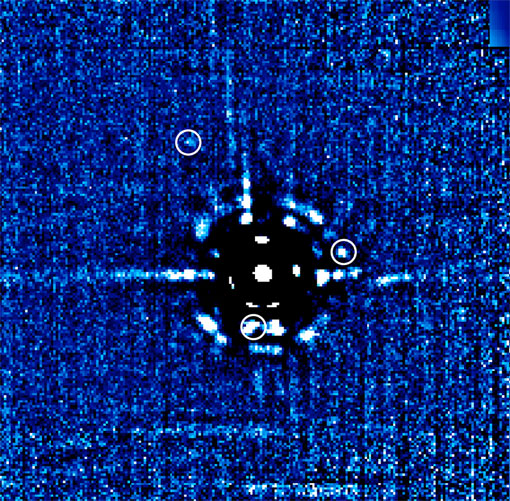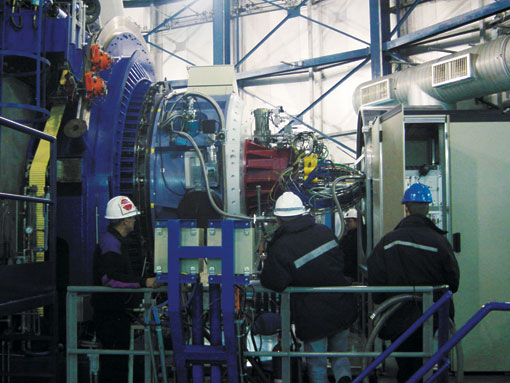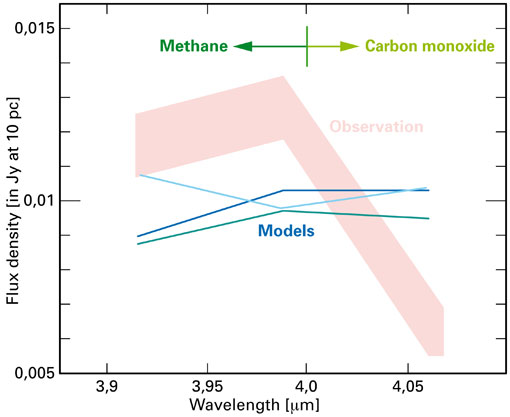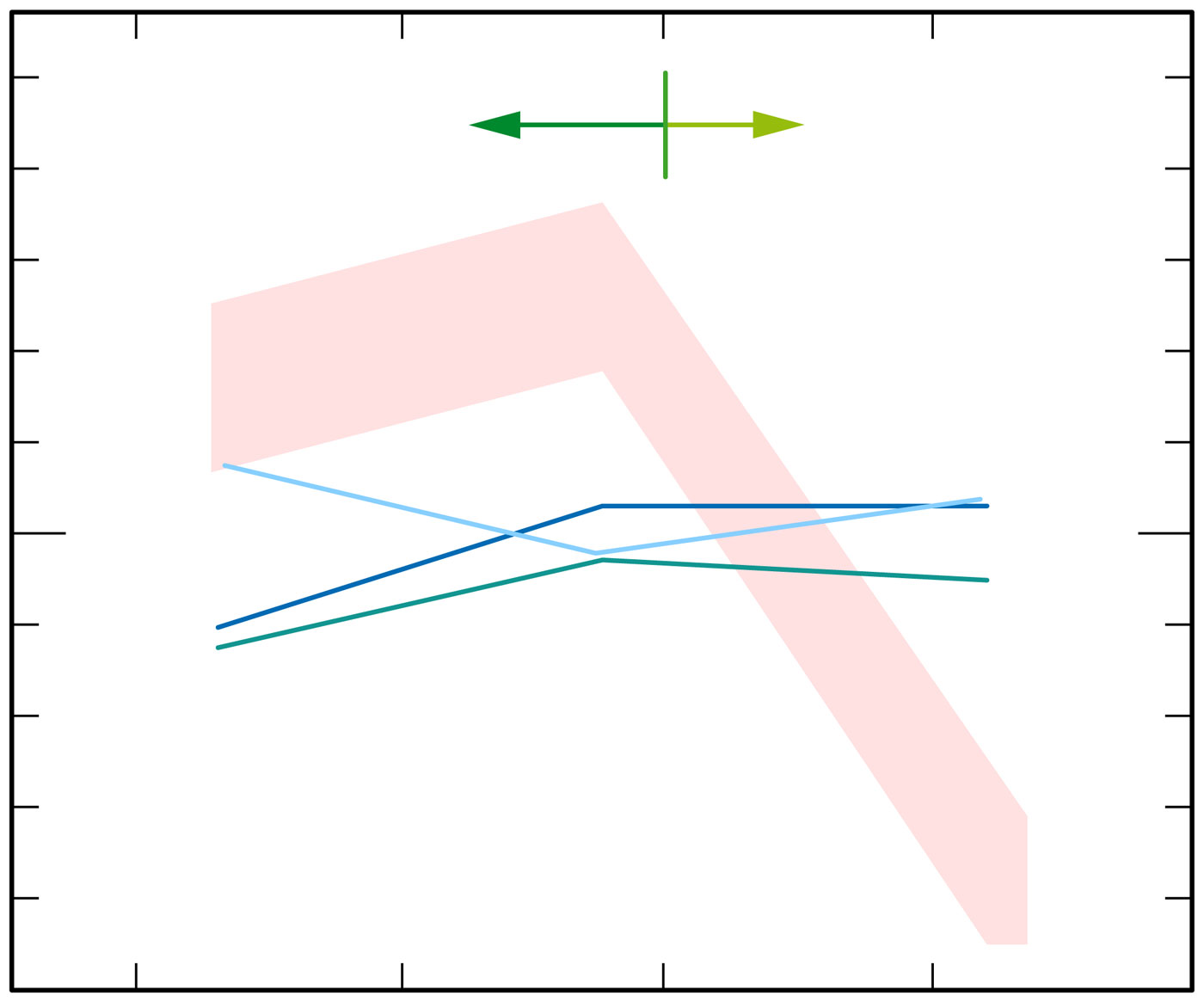|
|
| MPIA Science Release 2010-01-13 |
First Direct “Chemical Fingerprint” of an Exoplanet orbiting a Sun-Like Star
Astronomers have obtained the first direct spectrum – a “chemical fingerprint” – of a planet orbiting a distant, Sun-like star, providing direct data about the composition of the planet's atmosphere. Such “chemical fingerprinting” is a key technique in the search for habitable planets around other stars. As such, the result represents a milestone in the search for life elsewhere in the Universe. More directly, results like this are expected to provide new insight into how planets form.
| Figure 1: Image of the HR 8799 system. In the center, the host star HR 8799. Further investigation shows that three of the specks surrounding the star are planets (marked): Starting at 11 o'clock, clockwise: HR 8799b, HR8799c and HR8799d. The other specks and patterns are artefacts, which are unavoidable in a challenging observation like this one – star and planets are extremely close, and the star is a few thousand times brighter than the planets. The distance from the star to HR 8799c corresponds to 38 times the average Earth-Sun distance. Image credit: MPIA / W. Brandner [Larger version for download] |
 |
| Contact | Background information | Questions and answers | Images for download |
The search for life on other planets is one of the most exciting endeavours of modern astronomy. Over the past decade, astronomers have discovered more than 400 exoplanets (that is, planets orbiting stars other than the Sun). In order to judge a planet's habitability, or even detect tell-tale traces of habitation, astronomers need to do more than just detect such planets: They need to find out what the planet – more specifically, its atmosphere – is made of. To this end, they need to obtain the planet's spectrum, a “chemical fingerprint” that can be measured by examining the light received from the planet. Now astronomers have, for the first time, measured the spectrum of an exoplanet orbiting a Sun-like star directly – an important step in the ongoing search.
The research team, which includes three researchers from the Max Planck Institute for Astronomy (MPIA) and two from Canadian universities, studied the planetary system around the bright, very young star HR 8799, 130 light-years from Earth, located within the constellation Pegasus. The planetary system resembles a scaled-up version of our own Solar System and includes three giant planets, which had been detected in 2008 in another study. “Our target was the middle planet of the three, which is roughly ten times more massive than Jupiter and has a temperature of about 800 degrees Celsius,” says team member Carolina Bergfors (MPIA), who participated in the observations as part of her PhD work. The researchers recorded the spectrum using the NACO instrument installed at the European Southern Observatory's Very Large Telescope (VLT) in Chile, in particular its combined camera/spectrograph CONICA, which was developed at the MPIA and at the Max Planck Institute for Extraterrestrial Physics.
As the host star is several thousand times brighter than the planet, and the two are very close, obtaining such a spectrum is an immense feat. Markus Janson of the University of Toronto, lead author of the paper reporting the new findings, explains: “It's like trying to see what a candle is made of, by observing it next to a blinding 300 Watt lamp – from a distance of 2 kilometres [1.3 miles].” Carolina Bergfors (MPIA), whose work on this project is part of her PhD studies, adds: “It took more than five hours of exposure time, but we were able to tease out the planet's spectrum from the host star's much brighter light.”
In time, the astronomers hope that this technique will help them gain a better understanding of how planets form. As a likely first step, they aim to record the spectra of the two other giant planets orbiting HR 8799 – which would represent the first time that astronomers would be able to compare the spectra of three exoplanets that form part of one and the same system. As a much more distant goal, the technique will allow astronomers to examine exoplanets for habitability, or even signs of life.
More immediately, the results pose something of a challenge to current models of the exoplanet's atmosphere. “The features observed in the spectrum are not compatible with current theoretical models,” explains MPIA's Wolfgang Brandner, a co-author of the study. “We need to take into account a more detailed description of the atmospheric dust clouds, or accept that the atmosphere has a different chemical composition than previously assumed.”
| top |
Contact information
Dr. Wolfgang Brandner (Coauthor)
Max Planck Institute for Astronomy, Heidelberg, Germany
Phone: (0|+49) 6221 – 528 289
E-mail: brandner@mpia.de
Dr. Markus Pössel (PR)
Max Planck Institute for Astronomy, Heidelberg, Germany
Phone: (0|+49) 6221 – 528 261
E-mail: poessel@mpia.de
| top |
Background Information
The results described here have been published as M. Janson et al., “Spatially resolved spectroscopy of the exoplanet HR 8799 c”, Letter to Astrophysical Journal.
The team is composed of M. Janson (University of Toronto, Canada), C. Bergfors, M. Goto, W. Brandner (Max-Planck-Institute for Astronomy), and D. Lafrenière (University of Montreal, Canada).
| top |
Questions & Answers
What is a spectrum?
As every rainbow demonstrates, white light can be split up into different colors. Astronomers artificially split up the light they receive from distant objects into its different colors (or “wavelengths”). However, where we distinguish five or six rainbow colors, astronomers map hundreds of finely nuanced colors, producing a spectrum – a record of the different amounts of light the object emits in each narrow color band. Also, where we see only a rainbow's visible light, astronomers probe other region of the electromagnetic spectrum. The spectra used here were obtained in the infrared region. The spectrum's properties – more light emitted at some colors, less light at others – provide tell-tale signs about the chemical composition of the matter producing the light. Infrared spectra are especially useful for identifying the presence of molecules. All in all, this makes spectroscopy, the recording of spectra, a key tool for astronomy: Spectra tell us what distant astronomical objects are made of.
What is new about this result?
This is the first spectrum that was directly measured for an exoplanet orbiting a Sun-like star. Most previous measurements relied on indirect measurements (watching an exoplanet pass directly behind its host star in an “exoplanetary eclipse”, and extracting the spectrum by comparing the light of the star before and after). One previous direct measurement was on a system involving an object that is either a Brown Dwarf (a “failed star” – an object that is not massive enough to become a star, but too massive to be a planet) or a very dim young star. Other direct measurements produced not a proper spectrum, but merely information about one very small sliver of a spectrum (a particular “spectral line”), conjecturally assigned to a star's exoplanet.
How does this help in the search for life on other planets?
This kind of spectroscopic measurement – only much more accurate than in this case! – will be needed to determine whether an exoplanet is suitable for harbouring life as we know it. This determination would be made by looking at the chemical composition of the planet's atmosphere. Furthermore, such studies could reveal indirect signs of existing life: The abundances of different molecules in a planet's atmosphere are regulated by the laws of chemistry. Certain deviations from these standard abundances indicate the presence of life-forms that process chemicals – for instance, the current abundance of oxygen in the Earth's atmosphere is mainly due to the activity of algae, more than 2 billion years ago. We still have a long way to go to find life on exoplanets – from the detection of smaller, more Earth-like planets to the development of more precise spectroscopic measurement techniques. But the technique pioneered here brings us an important step close to our goal.
What are the specific results?
The team was able to determine the spectrum of the planet – spatially distinct from the spectrum of the star – in the wavelength region between 3.88 and 4.08 micrometres. The spectrum is very noisy; taking an average ("smoothing") suppresses the noise and allows a comparison with the spectra predicted by theoretical models. Due to the noise, no spectral lines could be resolved. However, the comparison between the smoothed-out spectra shows a clear deviation between the observed spectral shape and that predicted by the current standard models, which assume chemical equilibrium between the different chemical elements present in the atmosphere, and a continuous temperature profile (hotter layers below colder layers). At longer wavelengths (above 4 micrometres), the planet is significantly fainter than expected, which points to molecular absorption in its atmosphere. The simplest explanation is that the atmosphere contains less methane and more carbon monoxide than previously assumed.
What does the HR 8799 system look like?
The star Hr 8799 has 1.5 times the mass of the Sun. Three giant companion planets were detected in 2008 by another team of researchers; they have masses between 7 and 10 times that of Jupiter. Their distances from their host star are between 20 and 70 times the Earth-Sun distance. The system also features two belts populated by smaller objects, similar to our Solar System's asteroid and Kuiper belts.
What telescopes were used to obtain these results?
The spectra were taken with the infrared instrument NACO, mounted on the Very Large Telescope (VLT) of the European Southern Observatory, in Chile. The measurements relied heavily on the extraordinary capabilities of the instrument's adaptive optics system, which corrects most of the blurring which occurs as light from astronomical objects passes through the Earth's turbulent atmosphere (which is visible to the naked eye as the stars' twinkling). Preparatory data were taken with the IRCS instrument at the Subaru telescope.
What does “HR 8799” stand for?
HR 8799 is star number 8799 in the Yale Bright Star Catalogue. The designation “HR” is a legacy of the Bright Star Catalogue's predecessor, the Harvard Revised Photometry Catalogue.
| top |
Images

Figure 2: The NaCo instrument, mounted at ESO's Very Large Telescope on Paranal in Chile. NaCo is a combination of adaptive optics (which counteracts some of the blurring effect of the Earth's atmosphere) and the camera/spectrograph CONICA, which was developed at the Max Planck Institute for Astronomy and the Max Planck Institute for Extraterrestrial Physics.
Image credit: ESO
[Larger version for download]
 |
Figure 3: Four of the five astronomers who recorded the exoplanet spectrum, left to right: Wolfgang Brandner (MPIA), Miwa Goto (MPIA), Markus Jansen (University of Toronto, lead author) and Carolina Bergfors (MPIA).
Image credit: MPIA
[Larger version for download]

Figure 4: A smoothed-out version of the spectrum that allows a comparison between theory and observation. The horizontal direction indicates wavelength, the vertical direction "flux density" (a measure of how much radiation reaches us from the planet at the wavelengths indicated). Clearly, compared with the prediction of the models, more radiation is received at shorter infrared wavelengths (left-hand side), and less radiation at longer wavelengths (right-hand side). This indicates that the models need to be rethought.
Image credit: MPIA
[Larger version for download]
| Name | Format | Colour Space | Resolution | Size | |
 |
PR100112_1.jpg | JPG | RGB | 510 x 500 pxl | 172 KB |
| PR100112_1_gr.jpg | JPG | RGB | 800 x 786 pxl | 352 KB | |
| PR100112_1_hr.jpg | JPG | RGB | 1200 x 1179 pxl | 720 KB | |
| PR100112_1.pdf | RGB | – | 100 KB | ||
 |
PR100112_2.jpg | JPG | RGB | 510 x 383 pxl | 60 KB |
| PR100112_2_gr.jpg | JPG | RGB | 1200 x 900 pxl | 120 KB | |
| PR100112_2_hr.jpg | JPG | RGB | 1200 x 900 pxl | 228 KB | |
| CONICA.tif | TIFF | RGB | 2048 x 1536 pxl | 7 MB | |
 |
PR100112_3.jpg | JPG | RGB | 510 x 543 pxl | 68 KB |
| PR100112_3_gr.jpg | JPG | RGB | 800 x 852 pxl | 140 KB | |
| PR100112_3_hr.jpg | JPG | RGB | 1200 x 1278 pxl | 276 KB | |
| group_portrait.tiff | TIFF | RGB | 2048 x 1536 pxl | 17,5 MB | |
 |
PR100113_4en.jpg | JPG | RGB | 510 x 423 pxl | 28 KB |
| PR100113_4en_gr.jpg | JPG | RGB | 800 x 663 pxl | 40 KB | |
| PR100113_4en_hr.jpg | JPG | RGB | 1800 x 1492 pxl | 120 KB | |
| PR_100113_4en.pdf | CMYK | – | 16 KB | ||
| PR100113_4os_hr.jpg (without caption) |
JPG | RGB | 1400 x 1165 pxl | 68 KB | |
| PR_100113_4os.pdf (without caption) |
CMYK | – | 12 KB | ||
| top |